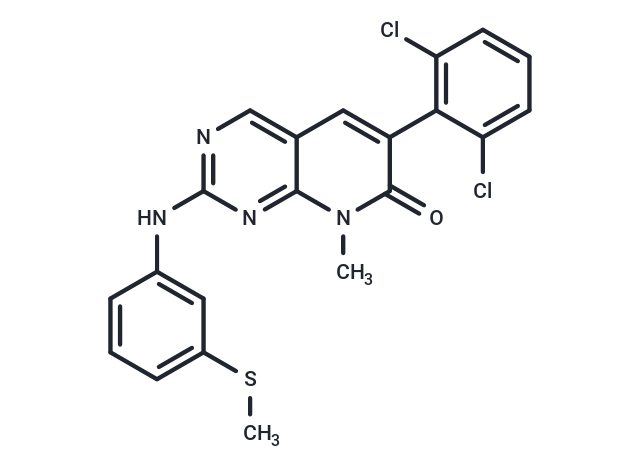Shopping Cart
- Remove All
 Your shopping cart is currently empty
Your shopping cart is currently empty

PD173955 is src family-selective tyrosine kinase inhibitor with IC50 of ~22 nM for Src, Yes and Abl kinase; less potent for FGFRα and no activity on InsR and PKC.

| Pack Size | Price | Availability | Quantity |
|---|---|---|---|
| 1 mg | $40 | In Stock | |
| 5 mg | $81 | In Stock | |
| 10 mg | $147 | In Stock | |
| 25 mg | $297 | In Stock | |
| 50 mg | $459 | In Stock | |
| 100 mg | $689 | In Stock | |
| 1 mL x 10 mM (in DMSO) | $166 | In Stock |
| Description | PD173955 is src family-selective tyrosine kinase inhibitor with IC50 of ~22 nM for Src, Yes and Abl kinase; less potent for FGFRα and no activity on InsR and PKC. |
| Targets&IC50 | Src:22 nM |
| In vivo | PD173955 serves as a Src inhibitor, effectively inhibiting mitotic progression during the early stages of mitosis across various cell types while inducing apoptosis to varying degrees. It efficiently suppresses Bcr-Abl-dependent cellular growth, displaying an IC50 value of 2-35 nM in Bcr-Abl-positive cell lines, which is approximately 100 to 200 times more sensitive than in Bcr-Abl-negative cell lines. Additionally, PD173955 inhibits the stem cell factor-dependent proliferation of M07e cells by blocking the ligand-dependent autophosphorylation of c-kit, with an IC50 of 40 nM. |
| Kinase Assay | In Vitro Bcr-Abl Kinase Assays: Bcr-Abl complexed to SHIP2 is immunoprecipitated from cell lysates of K562 cells maintained in log-phase culture conditions. Complexes are collected on protein A-Sepharose, and complexes are washed three times in lysis buffer and then washed twice in abl kinase buffer [50 mM Tris (pH 8.0), 10 mM MgCl2, 1 mM DTT, 2 mM p-nitrophenylphosphate, and 2 μM ATP; New England Biolabs Buffer and protocol]. Kinase assays are performed with 10 μM [γ-32P]ATP/sample for 15–60 min at 30°C in the presence or absence of the indicated concentrations of drug. The reaction is stopped by the addition of SDS-PAGE sample buffer and heated at 100°C for 10 min. Proteins are separated on 7.5% SDS-polyacrylamide gels, gels are dried under vacuum, and phosphorylation is visualized by autoradiography on X-ray film. |
| Cell Research | Cell growth is determined by two methods. For the [3H]thymidine assay, cells (104 cells/well) are cultured in 96-well, round-bottomed plates with diluted DMSO (control) or with varying concentrations of a specific compound that is resuspended in DMSO for 48 h at 37°C. [3H]Thymidine is added at a concentration of 1 μCi/well, and cells are incubated for an additional 18 h. Cells were harvested with the Unifilter system, scintillation fluid (25 μl/well) is added to each well, and [3H]thymidine incorporation is determined on a Packard Scintillation Counter. Data points for all assays are obtained in triplicate, and background incorporation from cell-free wells is determined and subtracted from all data points. For cell viability, control and drug-treated harvested cells are counted on a hemocytometer using the trypan blue dye exclusion method.(Only for Reference) |
| Alias | PD-173955, PD 173955 |
| Molecular Weight | 443.35 |
| Formula | C21H16Cl2N4OS |
| Cas No. | 260415-63-2 |
| Smiles | CSc1cccc(Nc2ncc3cc(-c4c(Cl)cccc4Cl)c(=O)n(C)c3n2)c1 |
| Relative Density. | 1.49 |
| Storage | store at low temperature | Powder: -20°C for 3 years | In solvent: -80°C for 1 year | Shipping with blue ice. | |||||||||||||||||||||||||
| Solubility Information | Ethanol: < 1 mg/mL (insoluble or slightly soluble) DMSO: 12 mg/mL (27.1 mM) | |||||||||||||||||||||||||
Solution Preparation Table | ||||||||||||||||||||||||||
DMSO
| ||||||||||||||||||||||||||

Copyright © 2015-2024 TargetMol Chemicals Inc. All Rights Reserved.